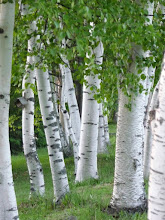In the spring, I tried starting indigo seeds in flats indoors. It did not work. In early June I found some seedlings at Twin Pond Farm's spring plant sale. The Japanese Indigo (polygorium tinctorium) plants I bought that day loved growing in our raised beds here at our bit of earth.
Last Saturday I pulled all the plants, stripped the leaves from the stems and ended up with about a pound and a half to work with.
A pound of leaves filled this large pickle jar. I covered the leaves with water, put a lid on the jar (not tight!) and set it in a large pot of water. I kept the temperature in the vat steady at around 170 degrees F for about three hours.
Over the years, I have collected several beautiful books about indigo and shibori and dying. I ended up using A Garden to Dye For by Chris McLaughlin. It's a lovely little book, with simple and easy to follow instructions.
When I got to the step in the process where I had to oxygenate the vat I felt that our decision to splurge on the farmer's style stainless steel kitchen sink was justified. Slowly pouring the the dye solution from one vessel to the next...back and forth for about 10 minutes...with plenty of room and no chance of staining...exhale with relief!
I dyed a silk scarf (the more turquoise result) and a yard of linen (the rich blue solid). I also played around with a few shibori techniques on cotton with varying results.
(I found a variety of necessary supplies for this project at Dharma Trading Co.)
(I found a variety of necessary supplies for this project at Dharma Trading Co.)
I've had a life long love of all things indigo. Growing my own plants, harvesting them and then using them to dye fabric has been on my bucket list forever. Finally accomplishing this project was so deeply satisfying for me.
There are a few coreopsis tops drying in the woodshed and the tansy is still blooming in the gardens...
How about you, dear readers...have you tried fiber dying? I'd love to hear of your results!






















